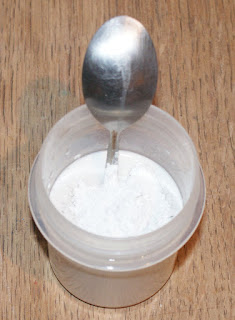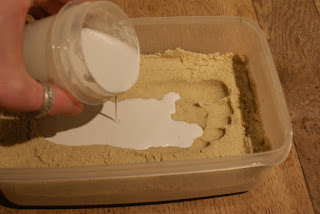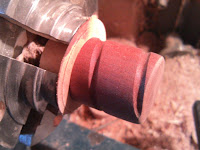There are times when not having a car can be problematic, and since the kids are now too big for push chairs and buggies we now have to do a lot of carrying of bags and such like, which if I'm honest is a pain, especially on library day (shudders) you'd be surprised how books will fit into a bag, there's also the chicken feed run, the bags of feed and corn weigh in at 20kg each, so I figured it was high time I did something to make things a little easier, that didn't involve the very expensive learning to drive and buy a car bit.
And this is it -
 | | |
| It'll give the neighbours something to talk about. |
This is quite a large build, but I'll try and condense it down as much as I can, without missing anything important out.
Basically this is built in much the same way we used to build go-carts when we were kids (many moons ago) I've even used the old buggy wheels from my daughters old (and broken) buggy.
The only things I bought for this was a sheet of 12mm plywood and two long bolts & nuts and a few large washers, everything else I either had lying about or made by hand, such as the yoke (the bit that allows it to turn) and the handle for pulling it.
So first things first, I marked out a half sheet of plywood (which you can get cut in store if you don't have a power saw) and then trimmed it to the size I wanted, which in this case was just under 1 metre long and about 50cm wide (not that much different in size to the buggy the wheels came of)
The Plywood -
 |
| You can just make out the lines. |
What you are aiming for though is a rough 'T' shape, at least if you build one the way I have that's what you'll want, once I had the rough shape I then used one of my wife's cake tins to mark out the curves on the front and the sides (shh don't tell her I used the tin) When you mark out your sheet make sure it fits between the wheels you use, especially if they have axles, in short build the frame of the cart to fit the wheels, rather than make the wheels fit the cart, and if you don't have any wheels you can buy wheel kits for making go-carts and pull carts.
The front and sides -
 |
| Sweeping curves for aerodynamic purposes. |
I marked two points on the front end for the pivot that will allow the front axle to turn, mainly because I can then use smaller wheels (when I find some) as it is the buggy wheels are 12 inches, so I had to accommodate them, but it will just mean a little trim here and there when and if I find smaller wheels.
Next I made the axles, now this required a router, and depending on the wheels you have I'd suggest doing things this way for extra strength.
The wheels (with axles) -
 |
| Now just to beef them up a bit. |
To add a little extra strength to the axles I made a channel in a length of wood which then fits round the old axle, this also made fixing things together a bit easier.
The wood, with channels cut out -
 |
| The one channel is meant to be off centre. |
New axles (front) -
New axles (back) -
 |
| I used some glue to make sure they don't move about. |
Fixing the back axle was just a matter of lining it up where I wanted it, and then screwing through the ply wood sheet into the wood of the axle.
The back axle fixed -
 |
| Sturdy enough. |
Having got this far I then had to think about the yoke, which is the bit that allows you to pull the cart and steer it, now had I been building this in metal I could have welded up some thin steel in half the time it took me to build the front axle assembly, but I wanted to see if I could do it in wood, well why not ?
The front axle with yoke -
 |
| I turned out quite well. |
It has to be said that had I gone for a two wheeled type cart then I wouldn't have need a front axle, or a way to steer it, but such is life.
The yoke is made from two bit of plywood with a piece of the same wood I'd used for the axles, it may bit a little bigger than it needs to be, but I figured I'd make it as strong as I could, but keep the whole thing relatively light weight, as it stands the whole completed cart weighs in at 11kg (yes I did weigh it) which isn't too bad.
A slightly better picture of the yoke and front axle -
 |
| It was 'D' shaped originally, but I thought I'd make it more interesting. |
You can (sort of) see how it fits onto the front axle, the steering bolt goes through the frame of the cart and then through the axle, which is why the channel for the axle is off centre (to allow for the bolt) and through the yoke, you can also see there's a fair sized gap between the handle and the sides of the yoke (above the bolt) so much so that I decided to pack that part out with some thick washers, it shouldn't be a problem, but this will be one of the major stress points when we use the cart, but as it turns easily, even with a heavy weight in it (I tested it by standing in the cart) I think it'll be fine, guess I'll find out when we start using it.
The yoke again with the packing washers -
 |
| Seems better like this. |
There are also a couple of washers between the main frame and the front axle, where it pivots for steering purposes, this should stop things rubbing together, you can see the gap between the two bits of plywood in the picture above.
Here's a top view of the front axle -
 |
| You can see how the axle pivots on the large bolt. |
I also added two support beams under the cart, the plywood was strong enough to hold my weight (I weigh 13 stones) but I figured better safe than sorry, and adding the extra supports also stopped a little bit of flexing in the main frame.
Extra supports -
 |
| Makes thing a lot stronger. |
As for the arm and the handles either side of it, I made these from a piece of wood left over form making the axles, and a bit of old fence post.
The arm -
 |
| Again curved for better aerodynamics. |
Where I've used bolts on the cart I've also used some steel tube (which came from the old buggy) to sheath the bolts, this will stop the threads digging into the wood, it also should help to make things like the yoke more secure.
The arm bolt and sheath -
 |
| I've used the same method on the main steering pivot. |
The handles for pulling the cart -
 |
| They aren't quite identical. |
I turned the handles quickly (perhaps a little too quickly) on my lathe, from an old bit of fence post, they fit into the arm with a screw and a load of strong glue.
Handles fitted to the arm -
 |
| All fixed. |
For the sides of the box that will hold whatever we put in it I used plywood for the first section, then some thin tongue and groove to build the sides up, mainly because I ran out of ply wood, and to be honest I prefer the way the tongue and groove looks, kind of gives it an old fashioned feel (well I think it does) and then I painted it all in black gloss, because painting anything black makes it go faster.
Before it was painted though I did have to make a few adjustments, the first being the turning circle, or the lack of a good one, so I cut out a little extra from each side.
Final adjustments -
 |
| Taking out an extra inch made all the difference. |
The other small problem was that when the steering was in full lock the tires rubbed on the frame, so to fix that I added a couple of stoppers to each side of the axle.
You can see how the tires rubbed in the next picture -
 |
| Not that much of a problem, but a problem all the same. |
Whilst this isn't really an issue, it might cause problems while turning the cart, and I didn't want the tires rubbing on the frame.
The stoppers -
 |
| I had to touch up the paint job a bit. |
Basically all the stoppers do is 'stop' the axle from turning quite so much, I think they stop the tires about 10mm from the frame, which still keeps the turning circle.
Here's what I mean -
 |
| A simple solution. |
And that's about it, I am planning on drawing up some detailed instructions for some of the things I've made (including this) my descriptions aren't always the best, so keep an eye out for them appearing on here at some point, although I've made a pull cart it wouldn't take much to make a go-cart using this type of method.
Ready for it's first job, which is most likely going to be a trip for chicken feed for over winter, and a trip to the library, the kids will very pleased they can once again clear the shelves of books to read at home, without dad moaning about the massive amount of books he has to carry.
Thanks for reading.






























































